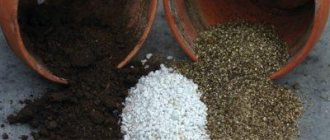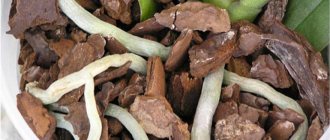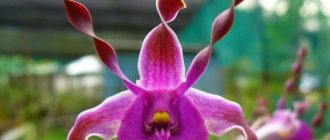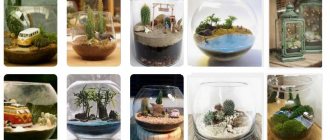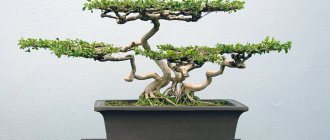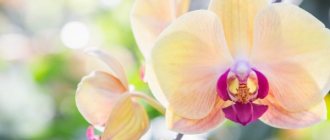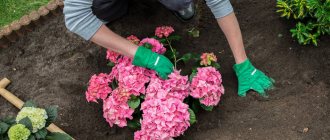Orchids are one of the largest representatives of the monocotyledonous plant family. They are among the oldest officially documented flowers. At the moment, orchids are distributed throughout the world, except Antarctica.
There are a large number of fans of this flower. Many people plant it in garden beds, small plots, and even on the windowsill in an apartment. In order to make this plant comfortable, many people use non-standard solutions and unusual methods of planting and caring for plants. Through trial and error, a large number of different options were invented for how best to plant an orchid.
One of the most successful methods in recent times has been planting orchids in foam glass. What is it and why is it necessary?
Foam glass for planting orchids is a foamed substrate that has excellent moisture-holding properties. It is able to absorb water in a very short period of time. For comparison, pine bark needs to be soaked for 1-2 hours. It is also worth noting that, in comparison with bark, foam glass soil can absorb 20-25% more water, and also release moisture 10-15% longer.
What is used as soil?
Since there is no single recipe for preparing orchids, a variety of components may be present in the soil, for example:
- tree bark (provides good breathability);
- sphagnum moss;
- charcoal;
- fern roots;
- coconut fiber;
- oak leaves;
- high peat;
- expanded clay;
- Styrofoam;
- nutshell.
It is best to collect tree bark from dead trees. In this case, there is no resin and harmful insects on it.
The main positive indicators of foam glass for orchids
- Foam glass is quite durable in use (does not crumble or break over time);
- An excellent way to maintain moisture-air balance;
- Well suited for helping in the growth and intensive development of the plant;
- The use of this substrate does not allow plants to rot;
- Maximum nutrient uptake by roots.
Due to its unusual, porous structure, foam glass accumulates water in the micropores of the soil, while evaporation occurs through macrospores. In this regard, oxygen penetrates to the roots of the plant and nourishes them.
How to disinfect the soil?
Depending on the characteristics of the component included in the soil, in order to disinfect it, you can use one of the following methods:
- treatment with boiling water;
- roasting in the oven;
- boil for several minutes;
- spilling with a weak solution of potassium permanganate.
The disinfected components are thoroughly dried and only then placed in the substrate.
Read here what components should be included in the soil composition for a phalaenopsis orchid.
Planting an orchid in expanded clay
Experienced orchid growers claim that they grow various orchids in expanded clay - cymbidium, paphiopedilum, cattleya, dendrobium and hybrid phragmipedium, phalaenopsis, vanda. The resuscitation of plants with problem roots is especially successful - new roots form in expanded clay quite quickly and give significant growth. True, the adaptation of a healthy root system to an expanded clay substrate is not always successful - there is an interchange of old roots with new ones.
To plant orchids, choose a plastic and transparent pot, in which it is possible to observe the change in the condition of the roots. However, holes in it should only be in the walls; their presence at the bottom is excluded.
Through selection, experienced orchid growers determined that for containers with a volume of 300–500 ml, holes for draining irrigation water are located in a row at a height of 1 cm from the bottom. Accordingly, the larger the container, the higher the holes - for pots of 500-1000 ml, approximately 1.5 cm, for pots with a volume of 1.5-2 liters - at least 2 cm from the bottom level.
For vanda, additional holes are made along the entire wall of the pot to improve air aeration. The diameter of expanded clay granules is also different: for plants with thick roots, larger ones are taken; if the roots are thin, it is permissible to use substrate particles that are small in circumference.
It is best to transplant an orchid into expanded clay in the spring, with the beginning of all processes of growth and root formation. Expanded clay granules are soaked for a day in water with phytohormones, then the water is allowed to drain. The roots are located in the upper layers of the expanded clay substrate.
The essence of growing an orchid in expanded clay is the constant presence of water at the bottom, poured to the level of the holes.
DIY recipe for transplanting
To make your own soil at home, it is important to adhere to the main criteria:
- excellent air and moisture permeability;
- ease;
- acidity (pH) at 5.5-6.5.
The soil option tested by experienced gardeners contains:
- 5 parts pine bark;
- 2 parts sphagnum moss;
- 1 part charcoal;
- 1 part vermiculite or perlite.
Another popular substrate option contains the following components:
- 5 parts bark;
- 1 part peat;
- 1 part charcoal;
- 1 part fern roots;
- 3 parts sphagnum moss.
Care Tips
The rules for caring for a flower in a foam glass substrate are the same as for plants in regular soil. Watering orchids in foam glass can be done by immersion, overhead pouring or the “wet heels” method. It is best to combine the last two techniques, leaving the flowerpot immersed in water by 2-3 centimeters. This way the soil will always be saturated with moisture while it evaporates. The intervals between watering are 4-5 days in rooms with normal humidity. The main rule is that you just need to check the condition of the soil so as not to dry out or over-wet the roots.
Planting, caring for and watering plants in foam glass soil is no different from caring for a flower planted in tree bark. The structure of the substrate retains moisture well and allows oxygen to pass through, which promotes proper growth of the orchid. osbmarket.ru has foam glass crushed stone of different fractions from 5 mm to 30 mm, which is suitable for planting. To get advice from a manager, contact us by calling our hotline or place an order on the website.
ADVANTAGES AND WIDE RANGE OF SOIL APPLICATIONS:
FOAM GLASS SUBSTRATE GrowPlant is a universal substrate and soil additive - the best choice of a specialist and gardener, it has a wide range of applications in various situations.
FOAM GLASS SUBSTRATE GrowPlant is an effective alternative to perlite and expanded clay. It guarantees significantly higher aeration and faster drainage than perlite, while holding more water than expanded clay, and can also be used for hydroponic systems.
FOAM GLASS SUBSTRATE GrowPlant is an excellent alternative to the usual pine bark, distinguished by its excellent properties of absorbing and releasing moisture (hygroscopicity) and aeration properties.
— when using GrowPlant FOAM GLASS SUBSTRATE, plants do not rot, they develop intensively, because their roots receive the optimal ratio of moisture, oxygen and nutrients.
— the ability to use any containers, containers, pots, including plastic and glass (open and closed growing system).
- clean soil, without spills and dirt, without pests and rotting of the root system.
FOAM GLASS SUBSTRATE GrowPlant is universal and can solve all your problems.
Easy root control _
FOAM GLASS SUBSTRATE GrowPlant drains faster compared to other substrates and this provides an advantage. This property allows you to quickly replace or introduce additional nutrients, pH and moisture levels as needed by the plant at the time. As a result, vegetative processes in plantings are accelerated.
Frequent watering and fertilizing , without the risk root rotting and fungal diseases
Fast draining FOAM GLASS SUBSTRATE GrowPlant also allows you to take advantage of frequent feedings without the risk of overwatering or root rot and it reduces the plant's susceptibility to Pythium and other fungal diseases.
Use of silicon
Because GrowPlant FOAM GLASS SUBSTRATE is made from recycled glass, silicon is leached from its surface in a form that can be absorbed by plants - monosilicic acid (H4SiO4). Plants that accumulate silicon have a higher resistance to stress conditions and natural protection from external negative factors such as diseases, pests, pesticide treatments, lack of nutrients, etc. Another advantage of including silicon in the nutrition system is the reduction in loss of nutrients and water from the root layer (in greenhouses - reduced drainage), an increase in the volume of roots, as a result - a decrease in the amount of fertilizer applied and water consumption.
Versatility
FOAM GLASS SUBSTRATE GrowPlant is suitable for Hydroponics, both in private households and in large quantities in greenhouses. Can be used in soil mixtures for aeration, potting mixtures, for easy drainage, in Green roofs, as a top layer to control flies, fungus gnats (an environment unfavorable for their development), and in many other cases. FOAM GLASS SUBSTRATE GrowPlant during the production process can be saturated with any mineral substances and fertilizers, at the request of the customer, which increases its versatility as a carrier. Allows use as a long-acting fertilizer.
Multiple uses
FOAM GLASS SUBSTRATE GrowPlant can be used several times! Simply remove the old plant from the container and shake vigorously to release most of the roots. Steam or special solutions may need to be treated to remove possible pathogens.
Reviews of the closed landing system
According to reviews of flower growers who grew orchids using this method:
- the orchid grows roots well after drying out;
- the flooded flower must first be dried for a week and only then planted in a closed system;
- in such a closed container, children grow their root system well ;
- When cultivating a flower in this way, you need to carefully monitor the watering regime;
- an orchid does not always develop well in a closed system and it is not clear why its leaves and roots begin to die, then it is worth trying to grow it in the usual way.
There are so many orchid lovers, so many opinions, you just need to try a new method, and maybe the flower will adapt well to it and grow flower stalks.
What substances are inappropriate?
- Eggshell. Along with mollusk shells, it contains large amounts of calcium and other trace elements. Use as drainage is unacceptable;
- Dry leaves. As the layer of dry leaves deteriorates and decomposes, it will increasingly impede the outflow of water, which directly contradicts the purpose of drainage;
- Tree bark. It is already part of the orchid substrate. Pine, spruce or oak bark of a large fraction measuring 2-3 cm can be used as drainage, but it is better to put: Expanded clay;
- Pebbles;
- Or polystyrene.
- Mold;
Gribov;
It is better to find another use for the shell ;
Under no circumstances should marble chips be used instead of drainage.
Reanimation of an orchid in expanded clay
A plant that has lost its root system should not be thrown into the trash bin in a hurry. After carefully examining the orchid, clean it of rotten roots; if there are dark spots near the growing point, cut them off with a sterile instrument. All cut areas are sprinkled with foundation, cinnamon powder or charcoal and left to dry for a day.
Before cleaning, it is a good idea to immerse the plant in a solution of any biostimulator for the development of the root system - radiafarm, epin, zircon or kornevin, prepared in accordance with the instructions indicated on the package.
If after drying there are no darkened or wet spots, the orchid is planted in expanded clay. To do this, the substrate is thoroughly washed in warm water, then left for a while so that the granules are saturated with moisture, and the water is drained. Pour expanded clay into a pot and place the plant in it, taking care of how to strengthen the orchid without roots, for example, wrap a ribbon around the pagon and tie it to the flower container.
The pot with the “resuscitator” is placed in a mini-greenhouse and kept in compliance with the temperature and watering regime with good diffused lighting. Usually, if everything is done correctly, by the end of the second month of resuscitation the orchid grows miniature roots and subsequently increases their growth.
How to prepare drainage at home?
The material that you plan to use as drainage should be prepared and prepared in advance . It should be:
- Clean;
- Dry without traces of mold;
- And fungi.
It is advisable to disinfect it before use by calcining it in the oven. This applies not only to orchids, but in general to all plants that you replant. If necessary, place a small amount of drainage material at the bottom of the pot, necessary for the fraction of water to pass through easily, then you need to carefully place the plant in the pot, filling the free space with substrate.
